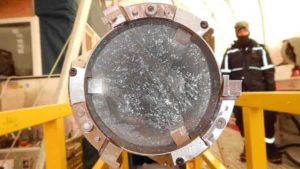
A new discovery by University of Maine researchers that challenges the established volcanic source of particles found in an ice core from the South Pole adds to the global record of volcanism and is relevant to several research disciplines.
Understanding how the Earth’s volcanic activity interacts with the climate system, as well as volcanic hazard mitigation studies and reconstructions of how past volcanic events have affected human history often rely on detailed records of past volcanic eruptions. Unfortunately, in many parts of the world, historical records are sporadic, short and not well documented, according to Andrei Kurbatov, associate professor at the University of Maine School of Earth and Climate Sciences and Climate Change Institute.
In the last decade, Kurbatov and Martin Yates, electron beam laboratory manager and instructor of Earth sciences at UMaine, in collaboration with Nelia Dunbar and Nels Iverson from the New Mexico Institute of Mining and Technology, developed a method of extracting volcanic ash particles from ice core samples to measure their geochemical composition.
The new methodology provides additional means to refine the history of global volcanism captured in polar ice core records, according to Kurbatov.
Laura Hartman, a graduate student at the CCI, used the methodology while examining microscopic volcanic ash particles in ice core samples from Antarctica’s South Pole. Hartman was advised by Kurbatov and Earth and Climate Sciences assistant professor Alicia Cruz-Uribe.
She found several particles from a volcanic interval that in the last three decades was attributed to a volcanic eruption from the Kuwae volcanic center in Vanuatu.
Hartman determined the geochemical signatures of the particles, that provide a unique volcanic source fingerprint, and compared the signatures with the known composition of Kuwae volcanic products.
She discovered the composition was similar to volcanic products from the South American volcano Reclus, not Kuwae.
“The discovery challenges the established volcanic source for one of the largest ice core sulfate signals from the last millennium,” Kurbatov says. “The new source location will impact how climate models calculate atmospheric loading and ultimately will guide how climate models determine the impact of this volcanic event on the climate system.”
The relatively young, unknown explosive volcanic eruption from Reclus volcano, located close to several national parks in South America, provides new important constraints for regional volcanic hazards assessments and air-traffic safety, Kurbatov says. The new data also question the existing paradigm on long-range transport of ultrafine volcanic particles in the atmosphere.
With funding from the National Science Foundation, Kurbatov and his team plan to continue to explore volcanic deposits in the South Pole ice core using the new methodology to further refine the global record of volcanism.
“Volcanic glass properties from 1459 C.E. volcanic event in South Pole ice core dismiss Kuwae caldera as a potential source” was published in Scientific Reports.
Reference:
Laura H. Hartman et al. Volcanic glass properties from 1459 C.E. volcanic event in South Pole ice core dismiss Kuwae caldera as a potential source, Scientific Reports (2019). DOI: 10.1038/s41598-019-50939-x
Note: The above post is reprinted from materials provided by University of Maine.









